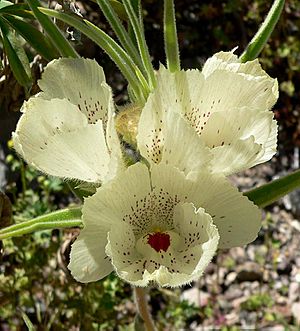Ghost flower facts for kids
Quick facts for kids Ghost flower |
|
|---|---|
 |
|
| Scientific classification | |
| Genus: |
Mohavea
|
| Species: |
confertiflora
|
The ghost flower, also known as Mohavea confertiflora, is a unique plant. It belongs to the Plantaginaceae family. This plant grows naturally in the dry areas of the Southwestern United States. You can find it in southern California and three states in northwest Mexico.
It lives in the very dry conditions of the Mojave Desert and the Sonoran Desert. This includes the Colorado Desert. It grows at elevations below 1,000 meters (about 3,300 feet). You can also spot it in special "sky island" habitats within these deserts.
About the Ghost Flower
The ghost flower blooms from March to April. This flower is quite special because it does not make nectar. Nectar is a sweet liquid that many flowers produce to attract insects.
Even without nectar, the ghost flower has found a clever way to get pollinated. It looks very similar to another flower called Mentzelia involucrata. Both flowers often grow in the same desert areas.
How it Attracts Pollinators
The Mentzelia involucrata flower produces nectar. It uses this nectar to attract female bees from the Xeralictus genus. These bees help pollinate the Mentzelia flower.
In places where both the ghost flower and Mentzelia grow, the ghost flower uses a trick. It attracts the same bees through something called floral mimicry. This means it copies the look of another flower.
The ghost flower has special marks on its petals. These marks look like female Xeralictus bees. Male bees see these marks. They think they are seeing a female bee. This visual signal is called a sign stimulus.
When a male bee sees these marks, it flies into the ghost flower. It tries to mate with what it thinks is a female bee. As the male bee moves around inside the flower, it accidentally picks up pollen. Then, it carries the pollen to another ghost flower. This helps the ghost flower reproduce.
Images for kids


